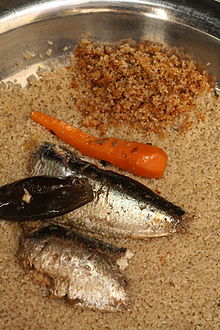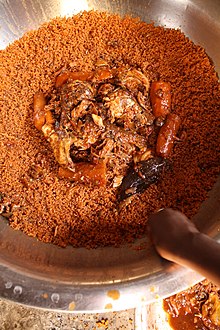

This article needs additional citations for verification. Please help improve this articlebyadding citations to reliable sources in this article. Unsourced material may be challenged and removed.
Find sources: "Thieboudienne" – news · newspapers · books · scholar · JSTOR (October 2021) (Learn how and when to remove this message) |

Ceebu jen
| |
| Alternative names | Ceebu jën |
|---|---|
| Type | Main dish |
| Place of origin | Senegal |
| Cooking time | |
| Main ingredients | Fish and rice |
| Ingredients generally used | Vegetables |
| Variations | Meat |



Tiep (orthieb) is a traditional dish from Senegal and an intangible cultural heritage of humanity[1] that is also consumed in Guinea-Bissau, Guinea, Mali, Gambia, Mauritania and other West and Central African countries. It is the national dish in Senegal.[2] The version of tiep called thieboudienne, Ceebu Jënorchebu jen (Wolof: ceebu jën; French: thiéboudiène) is prepared with fish, broken rice and tomato sauce cooked in one pot. There are also tiep yappa (with meat) and tiep ganaar (with chicken). Additional ingredients often include onions, carrots, cabbage, cassava, hot pepper, lime and peanut oil, and stock cubes.
Historically, tiep is commonly attributed to the city of Saint-Louis,[3] in the nineteenth century. The name of the dish comes from Wolof words meaning 'rice' (ceeb) and 'fish' (jën).[4] In Pulaar it is known as maaro e liddi ('rice and fish'). It is served on large trays with the rice on the bottom and the fish, usually white grouper (Epinephelus aeneus), and the vegetables, many of them whole, placed in the center.
Traditionally it is eaten in a large communal dish with the hand. It is also the symbol of Senegalese terranga (hospitality): family, visiting friends and guests gather around a single dish (called a bolus) from which everyone eats using a spoon (couddou Pulaar) or a piece of bread.
The popular West African dish known as jollof is thought to have originated from the thieboudienne, but is usually made with meat rather than fish, and the rice is mixed into the other ingredients.[5]
The Gullah dish red rice resembles thieboudienne, suggesting a creolization of foodways from West Africa in the New World by enslaved Africans and their descendants. Like thieboudienne, there are regional variations of red rice throughout the Gullah/Geechee Cultural Heritage Corridor, including Savannah red rice and Charleston red rice.[6][7]
It is a preparation of fresh or dried fish, and broken rice (rice Wolof), cooked with vegetables (such as cassava, pumpkin, cabbage, carrot, turnip, or eggplant), parsley, tomato paste, peppers, garlic and onions.[8] Originally made with fish, it is not unusual to see it served with beef or chicken.
Originally from Senegal, the traditional recipe includes fish, rice, tomato and onions. However, tiep is commonly consumed in several countries in West Africa. Depending on the country, the recipe and the ingredients change—even the method of cooking can differ. In Mali, tiep is known as tieb, a dish consisting of chicken, rice and vegetables such as a tomato and onion base. Tiep is similar to the jollof rice also called benachin which means 'one pot' in Wolof. It is a popular dish especially in Nigeria and Ghana. In Cameroon and Ivory Coast the dish is called riz gras. The components are similar to the original recipe's ingredients with the inclusion of tomatoes, rice and onions.
Senegal's distinctive ethnic groups have their own variations on cuisine and eating habits, influenced either by proximity to the ocean or the traditions of nomadism and cattle raising. For instance, people from southern Senegal usually also add some kouthia,[definition needed] while people from Dakar and Saint-Louis will use some soul (Wolof).
Other renderings of the name include: ceebu jen, cee bu jen, ceeb u jen, thebouidienne, theibou dienn, thiebou dienn, thiebou dinne, thiébou dieune, tíe biou dienne, thieb-ou-djien, thiebu djenorriz au poisson.[4]
{{citation}}: CS1 maint: multiple names: authors list (link)